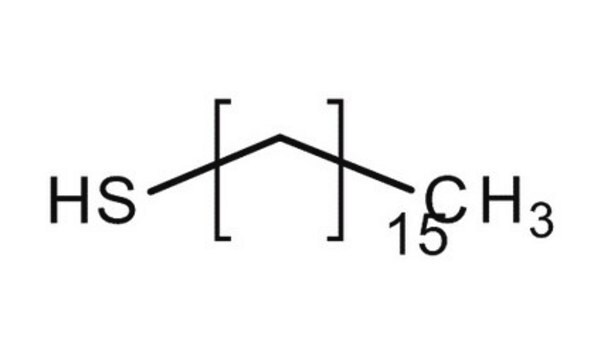674516
1-Hexadecanethiol
99%
Sinonimo/i:
Cetyl mercaptan, Hexadecyl mercaptan, Mercaptan C16
About This Item
Prodotti consigliati
Livello qualitativo
Saggio
99%
Indice di rifrazione
n20/D 1.462 (lit.)
P. eboll.
184-191 °C/7 mmHg (lit.)
Punto di fusione
18-20 °C (lit.)
20-24 °C
Densità
0.84 g/mL at 25 °C (lit.)
Temperatura di conservazione
2-8°C
Stringa SMILE
CCCCCCCCCCCCCCCCS
InChI
1S/C16H34S/c1-2-3-4-5-6-7-8-9-10-11-12-13-14-15-16-17/h17H,2-16H2,1H3
ORTRWBYBJVGVQC-UHFFFAOYSA-N
Cerchi prodotti simili? Visita Guida al confronto tra prodotti
Descrizione generale
Applicazioni
Codice della classe di stoccaggio
10 - Combustible liquids
Classe di pericolosità dell'acqua (WGK)
WGK 3
Punto d’infiammabilità (°F)
215.6 °F - closed cup
Punto d’infiammabilità (°C)
102 °C - closed cup
Dispositivi di protezione individuale
Eyeshields, Gloves, type ABEK (EN14387) respirator filter
Scegli una delle versioni più recenti:
Possiedi già questo prodotto?
I documenti relativi ai prodotti acquistati recentemente sono disponibili nell’Archivio dei documenti.
I clienti hanno visto anche
Articoli
Inorganic nanomaterials are tunable by size, shape, structure, and/or composition. Advances in the synthesis of well-defined nanomaterials have enabled control over their unique optical, electronic, and chemical properties stimulating tremendous interest across a wide range of disciplines. This article illuminates some of the recent research advances of inorganic nanoparticles (NPs) in optoelectronics applications.
Self-assembled monolayers (SAMs) have attracted enormous interest for a wide variety of applications in micro- and nano-technology. In this article, we compare the benefits of three different classes of SAM systems (alkylthiolates on gold.
Il team dei nostri ricercatori vanta grande esperienza in tutte le aree della ricerca quali Life Science, scienza dei materiali, sintesi chimica, cromatografia, discipline analitiche, ecc..
Contatta l'Assistenza Tecnica.










